Pong
Pong is a table tennis-themed arcade video game featuring simple two-dimensional graphics, manufactured by Atari and originally released in 1972. It was one of the earliest arcade video games and created by Allan Alcorn as a training exercise assigned to him by Atari co-founder Nolan Bushnell. Bushnell based the game's concept on an electronic ping-pong game included in the Magnavox Odyssey, the first home video game console. In response, Magnavox later sued Atari for patent infringement. Bushnell and Atari co-founder Ted Dabney were surprised by the quality of Alcorn's work and decided to manufacture the game.
| Pong | |
|---|---|
 An upright cabinet of Pong on display at the Neville Public Museum of Brown County | |
| Developer(s) | Atari |
| Publisher(s) | Atari |
| Designer(s) | Allan Alcorn |
| Platform(s) |
|
| Release | 29 November 1972 |
| Genre(s) | Sports |
| Mode(s) | Single-player, multiplayer |
| Cabinet | Upright |
| CPU | Discrete |
| Sound | Monaural (mono) |
| Display | Horizontal orientation, black-and-white raster display, standard resolution |
Pong was the first commercially successful video game, and it helped to establish the video game industry along with the Magnavox Odyssey. Soon after its release, several companies began producing games that closely mimicked its gameplay. Eventually, Atari's competitors released new types of video games that deviated from Pong's original format to varying degrees, and this, in turn, led Atari to encourage its staff to move beyond Pong and produce more innovative games themselves.
Atari released several sequels to Pong that built upon the original's gameplay by adding new features. During the 1975 Christmas season, Atari released a home version of Pong exclusively through Sears retail stores. The home version was also a commercial success and led to numerous clones. The game was remade on numerous home and portable platforms following its release. Pong is part of the permanent collection of the Smithsonian Institution in Washington, D.C., due to its cultural impact.
Gameplay
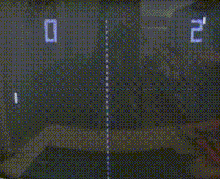
Pong is a two-dimensional sports game that simulates table tennis. The player controls an in-game paddle by moving it vertically across the left or right side of the screen. They can compete against another player controlling a second paddle on the opposing side. Players use the paddles to hit a ball back and forth. The goal is for each player to reach eleven points before the opponent; points are earned when one fails to return the ball to the other.[1][2][3]
Development and history
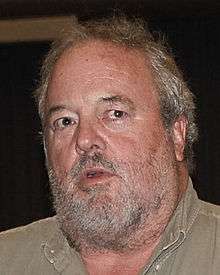
Pong was the first game developed by Atari.[4][5] After producing Computer Space, Bushnell decided to form a company to produce more games by licensing ideas to other companies. The first contract was with Bally Manufacturing Corporation for a driving game.[3][6] Soon after the founding, Bushnell hired Allan Alcorn because of his experience with electrical engineering and computer science; Bushnell and Dabney also had previously worked with him at Ampex. Prior to working at Atari, Alcorn had no experience with video games.[7] To acclimate Alcorn to creating games, Bushnell gave him a project secretly meant to be a warm-up exercise.[7][8] Bushnell told Alcorn that he had a contract with General Electric for a product, and asked Alcorn to create a simple game with one moving spot, two paddles, and digits for score keeping.[7] In 2011, Bushnell stated that the game was inspired by previous versions of electronic tennis he had played before; Bushnell played a version on a PDP-1 computer in 1964 while attending college.[9] However, Alcorn has claimed it was in direct response to Bushnell's viewing of the Magnavox Odyssey's Tennis game.[7] In May 1972, Bushnell had visited the Magnavox Profit Caravan in Burlingame, California where he played the Magnavox Odyssey demonstration, specifically the table tennis game.[10][11] Though he thought the game lacked quality, seeing it prompted Bushnell to assign the project to Alcorn.[9]
Alcorn first examined Bushnell's schematics for Computer Space, but found them to be illegible. He went on to create his own designs based on his knowledge of transistor–transistor logic and Bushnell's game. Feeling the basic game was too boring, Alcorn added features to give the game more appeal. He divided the paddle into eight segments to change the ball's angle of return. For example, the center segments return the ball a 90° angle in relation to the paddle, while the outer segments return the ball at smaller angles. He also made the ball accelerate the longer it remained in play; missing the ball reset the speed.[3] Another feature was that the in-game paddles were unable to reach the top of the screen. This was caused by a simple circuit that had an inherent defect. Instead of dedicating time to fixing the defect, Alcorn decided it gave the game more difficulty and helped limit the time the game could be played; he imagined two skilled players being able to play forever otherwise.[7]
Three months into development, Bushnell told Alcorn he wanted the game to feature realistic sound effects and a roaring crowd.[7][12] Dabney wanted the game to "boo" and "hiss" when a player lost a round. Alcorn had limited space available for the necessary electronics and was unaware of how to create such sounds with digital circuits. After inspecting the sync generator, he discovered that it could generate different tones and used those for the game's sound effects.[3][7] To construct the prototype, Alcorn purchased a $75 Hitachi black-and-white television set from a local store, placed it into a 4-foot (1.2 m) wooden cabinet, and soldered the wires into boards to create the necessary circuitry. The prototype impressed Bushnell and Dabney so much that they felt it could be a profitable product and decided to test its marketability.[3]
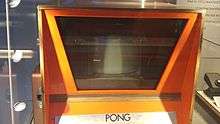
In August 1972, Bushnell and Alcorn installed the Pong prototype at a local bar, Andy Capp's Tavern.[13][14][15][16] They selected the bar because of their good working relation with the bar's owner and manager, Bill Gaddis;[17] Atari supplied pinball machines to Gaddis.[5] Bushnell and Alcorn placed the prototype on one of the tables near the other entertainment machines: a jukebox, pinball machines, and Computer Space. The game was well received the first night and its popularity continued to grow over the next one and a half weeks. Bushnell then went on a business trip to Chicago to demonstrate Pong to executives at Bally and Midway Manufacturing;[17] he intended to use Pong to fulfill his contract with Bally, rather than the driving game.[3][4] A few days later, the prototype began exhibiting technical issues and Gaddis contacted Alcorn to fix it. Upon inspecting the machine, Alcorn discovered that the problem was the coin mechanism was overflowing with quarters.[17]
After hearing about the game's success, Bushnell decided there would be more profit for Atari to manufacture the game rather than license it, but the interest of Bally and Midway had already been piqued.[4][17] Bushnell decided to inform each of the two groups that the other was uninterested—Bushnell told the Bally executives that the Midway executives did not want it and vice versa—to preserve the relationships for future dealings. Upon hearing Bushnell's comment, the two groups declined his offer.[17] Bushnell had difficulty finding financial backing for Pong; banks viewed it as a variant of pinball, which at the time the general public associated with the Mafia. Atari eventually obtained a line of credit from Wells Fargo that it used to expand its facilities to house an assembly line.[18] The company announced Pong on 29 November 1972.[19][20] Management sought assembly workers at the local unemployment office, but was unable to keep up with demand. The first arcade cabinets produced were assembled very slowly, about ten machines a day, many of which failed quality testing. Atari eventually streamlined the process and began producing the game in greater quantities.[18] By 1973, they began shipping Pong to other countries with the aid of foreign partners.[21]
Home version
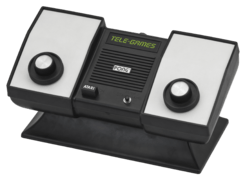
After the success of Pong, Bushnell pushed his employees to create new products.[4][22] In 1974, Atari engineer Harold Lee proposed a home version of Pong that would connect to a television: Home Pong. The system began development under the codename Darlene, named after an employee at Atari. Alcorn worked with Lee to develop the designs and prototype and based them on the same digital technology used in their arcade games. The two worked in shifts to save time and money; Lee worked on the design's logic during the day, while Alcorn debugged the designs in the evenings. After the designs were approved, fellow Atari engineer Bob Brown assisted Alcorn and Lee in building a prototype. The prototype consisted of a device attached to a wooden pedestal containing over a hundred wires, which would eventually be replaced with a single chip designed by Alcorn and Lee; the chip had yet to be tested and built before the prototype was constructed. The chip was finished in the latter half of 1974, and was, at the time, the highest-performing chip used in a consumer product.[22]
Bushnell and Gene Lipkin, Atari's vice-president of sales, approached toy and electronic retailers to sell Home Pong, but were rejected. Retailers felt the product was too expensive and would not interest consumers.[23] Atari contacted the Sears Sporting Goods department after noticing a Magnavox Odyssey advertisement in the sporting goods section of its catalog. Atari staff discussed the game with a representative, Tom Quinn, who expressed enthusiasm and offered the company an exclusive deal. Believing they could find more favorable terms elsewhere, Atari's executives declined and continued to pursue toy retailers. In January 1975, Atari staff set up a Home Pong booth at the American Toy Fair (a trade fair) in New York City, but was unsuccessful in soliciting orders due to high price of the unit.[24]
While at the show, they met Quinn again, and, a few days later, set up a meeting with him to obtain a sales order. In order to gain approval from the Sporting Goods department, Quinn suggested Atari demonstrate the game to executives in Chicago. Alcorn and Lipkin traveled to the Sears Tower and, despite a technical complication in connection with an antenna on top of the building which broadcast on the same channel as the game, obtained approval. Bushnell told Quinn he could produce 75,000 units in time for the Christmas season; however, Quinn requested double the amount. Though Bushnell knew Atari lacked the capacity to manufacture 150,000 units, he agreed.[22] Atari acquired a new factory through funding obtained by venture capitalist Don Valentine. Supervised by Jimm Tubb, the factory fulfilled the Sears order.[25] The first units manufactured were branded with Sears' "Tele-Games" name. Atari later released a version under its own brand in 1976.[26]
Lawsuit from Magnavox

The success of Pong attracted the attention of Ralph Baer, the inventor of the Magnavox Odyssey, and his employer, Sanders Associates. Sanders had an agreement with Magnavox to handle the Odyssey's sublicensing, which included dealing with infringement on its exclusive rights. However, Magnavox had not pursued legal action against Atari and numerous other companies that released Pong clones.[27] Sanders continued to apply pressure, and in April 1974 Magnavox filed suit against Atari, Allied Leisure, Bally Midway and Chicago Dynamics. Magnavox argued that Atari had infringed on Baer's patents and his concept of electronic ping-pong based on detailed records Sanders kept of the Odyssey's design process dating back to 1966. Other documents included depositions from witnesses and a signed guest book that demonstrated Bushnell had played the Odyssey's table tennis game prior to releasing Pong.[27][29] In response to claims that he saw the Odyssey, Bushnell later stated that, "The fact is that I absolutely did see the Odyssey game and I didn't think it was very clever."[30]
After considering his options, Bushnell decided to settle with Magnavox out of court. Bushnell's lawyer felt they could win; however, he estimated legal costs of US$1.5 million, which would have exceeded Atari's funds. Magnavox offered Atari an agreement to become a licensee for US$700,000. Other companies producing "Pong clones"—Atari's competitors—would have to pay royalties. In addition, Magnavox would obtain the rights to Atari products developed over the next year.[27][29] Magnavox continued to pursue legal action against the other companies, and proceedings began shortly after Atari's settlement in June 1976. The first case took place at the district court in Chicago, with Judge John Grady presiding.[27][29][31] To avoid Magnavox obtaining rights to its products, Atari decided to delay the release of its products for a year, and withheld information from Magnavox's attorneys during visits to Atari facilities.[29]
Impact and legacy
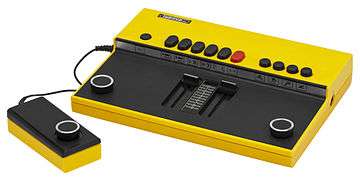
The Pong arcade games manufactured by Atari were a great success. The prototype was well received by Andy Capp's Tavern patrons; people came to the bar solely to play the game.[4][17] Following its release, Pong consistently earned four times more revenue than other coin-operated machines.[32] Bushnell estimated that the game earned US$35–40 per day, which he described as nothing he'd ever seen before in the coin-operated entertainment industry at the time.[9] The game's earning power resulted in an increase in the number of orders Atari received. This provided Atari with a steady source of income; the company sold the machines at three times the cost of production. By 1973, the company had filled 2,500 orders, and, at the end of 1974, sold more than 8,000 units.[32] The arcade cabinets have since become collector's items with the cocktail-table version being the rarest.[33] Soon after the game's successful testing at Andy Capp's Tavern, other companies began visiting the bar to inspect it. Similar games appeared on the market three months later, produced by companies like Ramtek and Nutting Associates.[34] Atari could do little against the competitors as they had not initially filed for patents on the solid state technology used in the game. When the company did file for patents, complications delayed the process. As a result, the market consisted primarily of "Pong clones"; author Steven Kent estimated that Atari had produced less than a third of the machines.[35] Bushnell referred to the competitors as "Jackals" because he felt they had an unfair advantage. His solution to competing against them was to produce more innovative games and concepts.[34][35]
Home Pong was an instant success following its limited 1975 release through Sears; around 150,000 units were sold that holiday season.[36][37] The game became Sears' most successful product at the time, which earned Atari a Sears Quality Excellence Award.[37] Atari's own version sold an additional 50,000 units.[38] Similar to the arcade version, several companies released clones to capitalize on the home console's success, many of which continued to produce new consoles and video games. Magnavox re-released their Odyssey system with simplified hardware and new features, and would later release updated versions. Coleco entered the video game market with their Telstar console; it features three Pong variants and was also succeeded by newer models.[36] Nintendo released the Color TV Game 6 in 1977, which plays six variations of electronic tennis. The next year, it was followed by an updated version, the Color TV Game 15, which features fifteen variations. The systems were Nintendo's entry into the home video game market and the first to produce themselves—they had previously licensed the Magnavox Odyssey.[39] The dedicated Pong consoles and the numerous clones have since become varying levels of rare; Atari's Pong consoles are common, while APF Electronics' TV Fun consoles are moderately rare.[40] Prices among collectors, however, vary with rarity; the Sears Tele-Games versions are often cheaper than those with the Atari brand.[36]
Several publications consider Pong the game that launched the video game industry as a lucrative enterprise.[8][26][41] Video game author David Ellis sees the game as the cornerstone of the video game industry's success, and called the arcade game "one of the most historically significant" titles.[4][33] Kent attributes the "arcade phenomenon" to Pong and Atari's games that followed it, and considers the release of the home version the successful beginning of home video game consoles.[34][37] Bill Loguidice and Matt Barton of Gamasutra referred to the game's release as the start of a new entertainment medium, and commented that its simple, intuitive gameplay made it a success.[26] In 1996 Next Generation named it one of the "Top 100 Games of All Time", recounting that "Next Generation staff ignor[ed] hundreds of thousands of dollars of 32-bit software to play Pong for hours when the Genesis version was released."[42] In 1999, Next Generation listed Pong as number 34 on their "Top 50 Games of All Time", commenting that, "Despite, or perhaps because of, its simplicity, Pong is the ultimate two-player challenge - a test of reaction times and very simple strategy stripped down to its barest essentials."[43] Entertainment Weekly named Pong one of the top ten games for the Atari 2600 in 2013.[44] Many of the companies that produced their own versions of Pong eventually became well known within the industry. Nintendo entered the video game market with clones of Home Pong. The revenue generated from them—each system sold over a million units—helped the company survive a difficult financial time, and spurred them to pursue video games further.[39] After seeing the success of Pong, Konami decided to break into the arcade game market and released its first title, Maze. Its moderate success drove the company to develop more titles.[45]
Bushnell felt that Pong was especially significant in its role as a social lubricant, since it was multiplayer-only and did not require each player to use more than one hand: "It was very common to have a girl with a quarter in hand pull a guy off a bar stool and say, 'I'd like to play Pong and there's nobody to play.' It was a way you could play games, you were sitting shoulder to shoulder, you could talk, you could laugh, you could challenge each other ... As you became better friends, you could put down your beer and hug. You could put your arm around the person. You could play left-handed if you so desired. In fact, there are a lot of people who have come up to me over the years and said, 'I met my wife playing Pong,' and that's kind of a nice thing to have achieved."[46]
Sequels and remakes
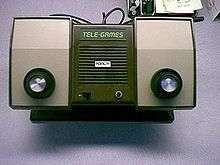
Bushnell felt the best way to compete against imitators was to create better products, leading Atari to produce sequels in the years following the original's release: Pong Doubles, Super Pong, Ultra Pong, Quadrapong, and Pin-Pong.[2] The sequels feature similar graphics, but include new gameplay elements; for example, Pong Doubles allows four players to compete in pairs, while Quadrapong—also released by Kee Games as Elimination—has them compete against each other in a four way field.[47][48] Bushnell also conceptualized a free-to-play version of Pong to entertain children in a Doctor's office. He initially titled it Snoopy Pong and fashioned the cabinet after Snoopy's doghouse with the character on top, but retitled it to Puppy Pong and altered Snoopy to a generic dog to avoid legal action. Bushnell later used the game in his chain of Chuck E. Cheese's restaurants.[2][49][50][51][52] In 1976, Atari released Breakout, a single-player variation of Pong where the object of the game is to remove bricks from a wall by hitting them with a ball.[53] Like Pong, Breakout was followed by numerous clones that copied the gameplay, such as Arkanoid, Alleyway, and Break 'Em All.[54]
Atari remade the game on numerous platforms. In 1977, Pong and several variants of the game were featured in Video Olympics, one of the original release titles for the Atari 2600. Pong has also been included in several Atari compilations on platforms including the Sega Genesis, PlayStation Portable, Nintendo DS, and personal computer.[55][56][57][58][59] Through an agreement with Atari, Bally Gaming and Systems developed a slot machine version of the game.[60] The Atari published TD Overdrive includes Pong as an extra game which is played during the loading screen.[61][62] A 3D platform game with puzzle and shooter elements was reportedly in development by Atari Corporation for the Atari Jaguar in September 1995 under the title Pong 2000, as part of their series of arcade game updates for the system and was set to have an original storyline for it,[63][64][65] but it was never released. In 1999, the game was remade for home computers and the PlayStation with 3D graphics and power-ups.[66][67] In 2012, Atari celebrated the 40th anniversary of Pong by releasing Pong World.[68]
In popular culture
The game is featured in episodes of television series including That '70s Show,[69] King of the Hill[70] and Saturday Night Live.[71] In 2006, an American Express commercial featured Andy Roddick in a tennis match against the white, in-game paddle.[72] Other video games have also referenced and parodied Pong; for example Neuromancer for the Commodore 64 and Banjo-Kazooie: Nuts & Bolts for the Xbox 360.[73][74] The concert event Video Games Live has performed audio from Pong as part of a special retro "Classic Arcade Medley".[75] Frank Black's song "Whatever Happened to Pong?" on the album Teenager of the Year references the game's elements.[76]
Dutch design studio Buro Vormkrijgers created a Pong-themed clock as a fun project within their offices. After the studio decided to manufacture it for retail, Atari took legal action in February 2006. The two companies eventually reached an agreement in which Buro Vormkrijgers could produce a limited number under license.[77] In 1999, French artist Pierre Huyghe created an installation titled "Atari Light", in which two people use handheld gaming devices to play Pong on an illuminated ceiling. The work was shown at the Venice Biennale in 2001, and the Museo de Arte Contemporáneo de Castilla y León in 2007.[78] The game was included in the London Barbican Art Gallery's 2002 Game On exhibition meant to showcase the various aspects of video game history, development, and culture.[79]
See also
References
- "Pong". Killer List of Videogames. Retrieved 22 October 2008.
- Sellers, John (August 2001). "Pong". Arcade Fever: The Fan's Guide to The Golden Age of Video Games. Running Press. pp. 16–17. ISBN 0-7624-0937-1.
- Kent, Steven (2001). "And Then There Was Pong". Ultimate History of Video Games. Three Rivers Press. pp. 40–43. ISBN 0-7615-3643-4.
- Ellis, David (2004). "A Brief History of Video Games". Official Price Guide to Classic Video Games. Random House. pp. 3–4. ISBN 0-375-72038-3.
- Kent, Steven (2001). "And Then There Was Pong". Ultimate History of Video Games. Three Rivers Press. pp. 38–39. ISBN 0-7615-3643-4.
- Kent, Steven (2001). "Father of the Industry". Ultimate History of Video Games. Three Rivers Press. pp. 34–35. ISBN 0-7615-3643-4.
- Shea, Cam (10 March 2008). "Al Alcorn Interview". IGN. Archived from the original on 27 July 2017. Retrieved 13 October 2008.
- Rapp, David (29 November 2006). "The Mother of All Video Games". American Heritage. Archived from the original on 17 May 2008. Retrieved 25 October 2008.
- Helgeson, Matt (March 2011). "The Father of the Game Industry Returns to Atari". Game Informer. GameStop (215): 39.
- "Video game history". R. H. Baer Consultants. 1998. Archived from the original on 23 December 2011. Retrieved 22 October 2008.
- Baer, Ralph (April 2005). Video Games: In The Beginning. New Jersey, USA: Rolenta Press. p. 81. ISBN 0-9643848-1-7.
- Morris, Dave (2004). "Funky Town". The Art of Game Worlds. HarperCollins. p. 166. ISBN 0-06-072430-7.
- "Pong 40th anniversary - Rooster T. Feathers - Features & Columns". www.metroactive.com. Archived from the original on 9 July 2017. Retrieved 9 May 2017.
- "Nov. 29, 1972: Pong, a Game Any Drunk Can Play". WIRED. Archived from the original on 1 September 2017. Retrieved 9 May 2017.
- "Pong - CHM Revolution". www.computerhistory.org. Archived from the original on 9 July 2017. Retrieved 9 May 2017.
- Goldberg, Harold. "The Origins of the First Arcade Video Game: Atari's Pong". Archived from the original on 11 January 2015. Retrieved 9 May 2017.
- Kent, Steven (2001). "And Then There Was Pong". Ultimate History of Video Games. Three Rivers Press. pp. 43–45. ISBN 0-7615-3643-4.
- Kent, Steven (2001). "The King and Court". Ultimate History of Video Games. Three Rivers Press. pp. 50–53. ISBN 0-7615-3643-4.
- "Production Numbers" (PDF). Atari. 1999. Archived (PDF) from the original on 20 January 2013. Retrieved 19 March 2012.
- "This Day in History: November 29". Computer History Museum. Archived from the original on 3 January 2018. Retrieved 28 November 2011.
- Kent, Steven (2001). "The Jackals". Ultimate History of Video Games. Three Rivers Press. p. 74. ISBN 0-7615-3643-4.
- Kent, Steven (2001). "Could You Repeat That Two More Times?". Ultimate History of Video Games. Three Rivers Press. pp. 80–83. ISBN 0-7615-3643-4.
- Kent, Steven L/ (2001). the Ultimate History of Video Games. Three Rivers Press. ISBN 0-7615-3643-4.
- Smith, Alexander (2019). My library My History Books on Google Play They Create Worlds: The Story of the People and Companies That Shaped the Video Game Industry, Vol. I: 1971-1982. CRC Press. ISBN 9780429752612. Retrieved 16 February 2020.
- Kent, Steven (2001). "Could You Repeat That Two More Times?". Ultimate History of Video Games. Three Rivers Press. pp. 84–87. ISBN 0-7615-3643-4.
- Loguidice, Bill; Matt Barton (9 January 2009). "The History Of Pong: Avoid Missing Game to Start Industry". Gamasutra. Archived from the original on 12 January 2009. Retrieved 10 January 2009.
- Baer, Ralph (1998). "Genesis: How the Home Video Games Industry Began". R. H. Baer Consultants. Archived from the original on 24 April 2016. Retrieved 22 October 2008.
- Kent, Steven (2001). "And Then There Was Pong". Ultimate History of Video Games. Three Rivers Press. pp. 45–48. ISBN 0-7615-3643-4.
- Nolan Bushnell (2003). The Story of Computer Games (video). Discovery Channel.
- Kent, Steven (2001). "A Case of Two Gorillas". Ultimate History of Video Games. Three Rivers Press. p. 201. ISBN 0-7615-3643-4.
- Kent, Steven (2001). "The King and Court". Ultimate History of Video Games. Three Rivers Press. pp. 53–54. ISBN 0-7615-3643-4.
- Ellis, David (2004). "Arcade Classics". Official Price Guide to Classic Video Games. Random House. p. 400. ISBN 0-375-72038-3.
- Kent, Steven (2001). "The Jackals". Ultimate History of Video Games. Three Rivers Press. pp. 60–61. ISBN 0-7615-3643-4.
- Kent, Steven (2001). "The King and Court". Ultimate History of Video Games. Three Rivers Press. p. 58. ISBN 0-7615-3643-4.
- Ellis, David (2004). "Dedicated Consoles". Official Price Guide to Classic Video Games. Random House. pp. 33–36. ISBN 0-375-72038-3.
- Kent, Steven (2001). "Strange Bedfellows". Ultimate History of Video Games. Three Rivers Press. pp. 94–95. ISBN 0-7615-3643-4.
- Booth, John (27 June 2012). "Timeline: A Look Back at 40 Years of Atari". Wired. Retrieved 14 August 2020.
- Sheff, David (1993). "In Heaven's Hands". Game Over: How Nintendo Zapped an American Industry, Captured Your Dollars, and Enslaved Your Children (1st ed.). Random House. pp. 26–28. ISBN 0-679-40469-4.
- Ellis, David (2004). "Dedicated Consoles". Official Price Guide to Classic Video Games. Random House. pp. 37–41. ISBN 0-375-72038-3.
- "Pong". IGN. Archived from the original on 2 July 2012. Retrieved 25 December 2008.
- "Top 100 Games of All Time". Next Generation. No. 21. Imagine Media. September 1996. p. 47.
- "Top 50 Games of All Time". Next Generation. No. 50. Imagine Media. February 1999. p. 76.
- Morales, Aaron (25 January 2013). "The 10 best Atari games". Entertainment Weekly. Archived from the original on 15 January 2018. Retrieved 17 April 2016.
- Retro Gamer Staff (August 2008). "Developer Lookback: Konami Part I". Retro Gamer. Imagine Publishing (53): 25.
- "What the Hell has Nolan Bushnell Started?". Next Generation. Imagine Media (4): 11. April 1995.
- "Pong Doubles". Killer List of Videogames. Retrieved 31 December 2008.
- "Quadrapong". Killer List of Videogames. Retrieved 31 December 2008.
- "Doctor Pong". Killer List of Videogames. Retrieved 31 December 2008.
- "Puppy Pong". Killer List of Videogames. Retrieved 31 December 2008.
- "Snoopy Pong". Killer List of Videogames. Retrieved 31 December 2008.
- Ellis, David (2004). "Dedicated Consoles". Official Price Guide to Classic Video Games. Random House. pp. 402. ISBN 0-375-72038-3.
- Kent, Steven (2001). "The Jackals". Ultimate History of Video Games. Three Rivers Press. p. 71. ISBN 0-7615-3643-4.
- Nelson, Mark (21 August 2007). "Breaking Down Breakout: System And Level Design For Breakout-style Games". Gamasutra. Archived from the original on 28 February 2011. Retrieved 23 February 2011.
- "Arcade Classics". IGN. Archived from the original on 13 July 2015. Retrieved 25 December 2008.
- Atari (20 December 2007). "Retro Arcade Masterpieces Hit Store Shelves in Atari Classics Evolved". GameSpot. Archived from the original on 13 September 2012. Retrieved 25 December 2008.
- Gerstmann, Jeff (23 March 2005). "Retro Atari Classics Review". GameSpot. Archived from the original on 16 March 2018. Retrieved 25 December 2008.
- "Atari: 80 Classic Games in One Company Line". GameSpot. 23 April 2004. Archived from the original on 5 September 2012. Retrieved 25 December 2008.
- Kohler, Chris (7 September 2004). "Atari opens up massive classic-game library". GameSpot. Archived from the original on 25 January 2018. Retrieved 25 December 2008.
- "Atari, Alliance Gaming to Develop Slots Based on Atari Video Games". GameSpot. 9 September 2004. Archived from the original on 11 January 2013. Retrieved 25 December 2008.
- Munk, Simon (4 May 2002). "PS2 Review: TD Overdrive". Computer and Video Games. Archived from the original on 9 March 2007. Retrieved 25 December 2008.
- Gestalt (18 August 2002). "TD Overdrive Xbox Review". Eurogamer. Archived from the original on 13 November 2011. Retrieved 25 December 2008.
- Quartermann (May 1995). "Gaming Gossip". Electronic Gaming Monthly. No. 70. Sendai Publishing. p. 54.
- Gore, Chris (September 1995). "The Gorescore - Industry News You Can - The Return of Pong". VideoGames - The Ultimate Gaming Magazine. No. 80. L.F.P., Inc. p. 20.
- Schmudde (5 November 2014). "Lost interview with Francois Yves Bertrand". AtariAge. Retrieved 12 April 2019.
- "Pong: The Next Level (PC)". IGN. Archived from the original on 31 October 2012. Retrieved 11 January 2009.
- "Pong: The Next Level (PlayStation)". IGN. Archived from the original on 26 October 2012. Retrieved 9 January 2009.
- "Atari celebrates 40 years of Pong with new, free iOS Pong game, custom portable Xbox 360". Engadget. Archived from the original on 6 September 2017. Retrieved 12 July 2015.
- "Punk Chick". That '70s Show. Season 1. Episode 22. 21 June 1999. Fox Broadcasting Company.
- "It Ain't Over 'Til the Fat Neighbor Sings". King of the Hill. Season 9. Episode 15. 15 May 2005. Fox Broadcasting Company.
- "Episode 5". Saturday Night Live. Season 1. Episode 5. New York City. 15 November 1975. NBC.
- Ashcraft, Brian (22 August 2006). "Roddick vs. Pong". Kotaku. Archived from the original on 29 June 2009. Retrieved 26 December 2008.
- Parker, Sam (13 February 2004). "The Greatest Games of All Time: Neuromancer". GameSpot. Archived from the original on 2 January 2013. Retrieved 14 January 2009.
- Anderson, Luke (11 September 2008). "Banjo-Kazooie: Nuts & Bolts Updated Hands-On". GameSpot. Archived from the original on 23 December 2017. Retrieved 14 January 2009.
- Microsoft (28 August 2007). "Microsoft Brings Video Games Live To London". GameSpot. Archived from the original on 19 July 2007. Retrieved 7 September 2008.
- Frank Black (Singer) (23 May 1994). Album: Teenager of the Year Song: Whatever Happened to Pong?. Elektra Records.
- Crecente, Brian (28 February 2006). "Atari Threatens Pong Clock Makers". Kotaku. Archived from the original on 12 July 2012. Retrieved 22 October 2008.
- "Tech rewind: Interesting facts about the hit arcade video game Pong". Mid Day. 29 November 2015. Archived from the original on 6 March 2017. Retrieved 5 March 2017.
- Boyes, Emma (9 October 2006). "London museum showcases games". GameSpot. Archived from the original on 23 March 2014. Retrieved 9 May 2008.
Further reading
- Cohen, Scott (1984). Zap! The Rise and Fall of Atari. McGraw-Hill. ISBN 978-0-07-011543-9.
- Herman, Leonard (1997). Phoenix: The Fall & Rise of Videogames. Rolenta Press. ISBN 978-0-9643848-2-8.
- Kline, Stephen; Dyer-Witheford, Nick; De Peuter, Greig (2003). Digital Play: The interaction of Technology, Culture and Marketing. McGill-Queen's Press. ISBN 978-0-7735-2591-7.
- Lowood, H. (2009). "Videogames in Computer Space: The Complex History of Pong". IEEE Annals of the History of Computing. 31 (3). pp. 5–19. doi:10.1109/MAHC.2009.53.
External links
| Wikimedia Commons has media related to Pong. |
- Pong-story.com, comprehensive site about Pong and its origins.
- The Atari Museum An in-depth look at Atari and its history
- THE Pong Flyer
- Pong variants at MobyGames